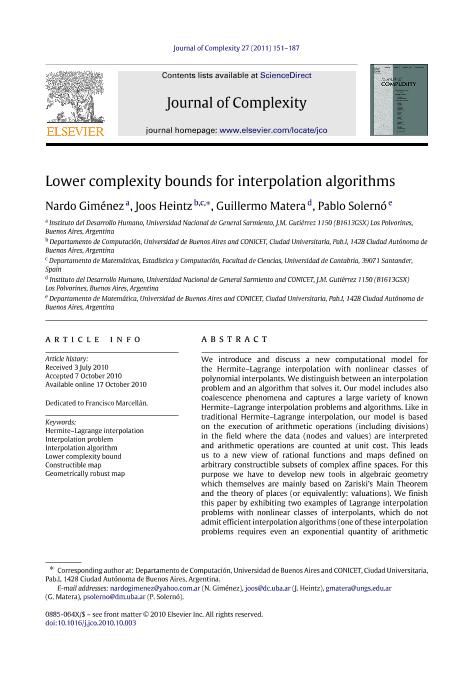Mostrar el registro sencillo del ítem
dc.contributor.author
Gimenez, Nardo Ariel

dc.contributor.author
Heintz, Joos Ulrich

dc.contributor.author
Matera, Guillermo

dc.contributor.author
Solernó, Pablo Luis

dc.date.available
2020-09-04T20:58:52Z
dc.date.issued
2011-04
dc.identifier.citation
Gimenez, Nardo Ariel; Heintz, Joos Ulrich; Matera, Guillermo; Solernó, Pablo Luis; Lower complexity bounds for interpolation algorithms; Academic Press Inc Elsevier Science; Journal Of Complexity; 27; 2; 4-2011; 151-187
dc.identifier.issn
0885-064X
dc.identifier.uri
http://hdl.handle.net/11336/113310
dc.description.abstract
We introduce and discuss a new computational model for the HermiteLagrange interpolation with nonlinear classes of polynomial interpolants. We distinguish between an interpolation problem and an algorithm that solves it. Our model includes also coalescence phenomena and captures a large variety of known HermiteLagrange interpolation problems and algorithms. Like in traditional HermiteLagrange interpolation, our model is based on the execution of arithmetic operations (including divisions) in the field where the data (nodes and values) are interpreted and arithmetic operations are counted at unit cost. This leads us to a new view of rational functions and maps defined on arbitrary constructible subsets of complex affine spaces. For this purpose we have to develop new tools in algebraic geometry which themselves are mainly based on Zariski's Main Theorem and the theory of places (or equivalently: valuations). We finish this paper by exhibiting two examples of Lagrange interpolation problems with nonlinear classes of interpolants, which do not admit efficient interpolation algorithms (one of these interpolation problems requires even an exponential quantity of arithmetic operations in terms of the number of the given nodes in order to represent some of the interpolants). In other words, classic Lagrange interpolation algorithms are asymptotically optimal for the solution of these selected interpolation problems and nothing is gained by allowing interpolation algorithms and classes of interpolants to be nonlinear. We show also that classic Lagrange interpolation algorithms are almost optimal for generic nodes and values. This generic data cannot be substantially compressed by using nonlinear techniques. We finish this paper highlighting the close connection of our complexity results in HermiteLagrange interpolation with a modern trend in software engineering: architecture tradeoff analysis methods (ATAM).
dc.format
application/pdf
dc.language.iso
eng
dc.publisher
Academic Press Inc Elsevier Science

dc.rights
info:eu-repo/semantics/openAccess
dc.rights.uri
https://creativecommons.org/licenses/by-nc-nd/2.5/ar/
dc.subject
HERMITE--LAGRANGE INTERPOLATION
dc.subject
INTERPOLATION PROBLEM
dc.subject
INTERPOLATION ALGORITHM
dc.subject
COMPUTATIONAL COMPLEXITY
dc.subject
LOWER COMPLEXITY BOUNDS
dc.subject
CONSTRUCTIBLE MAP
dc.subject
RATIONAL MAP
dc.subject
TOPOLOGICALLY ROBUST MAP
dc.subject
GEOMETRICALLY ROBUST MAP
dc.subject
HERMITE--LAGRANGE INTERPOLATION
dc.subject
INTERPOLATION PROBLEM
dc.subject
INTERPOLATION ALGORITHM
dc.subject
COMPUTATIONAL COMPLEXITY
dc.subject
LOWER COMPLEXITY BOUNDS
dc.subject
CONSTRUCTIBLE MAP
dc.subject
RATIONAL MAP
dc.subject.classification
Matemática Pura

dc.subject.classification
Matemáticas

dc.subject.classification
CIENCIAS NATURALES Y EXACTAS

dc.title
Lower complexity bounds for interpolation algorithms
dc.type
info:eu-repo/semantics/article
dc.type
info:ar-repo/semantics/artículo
dc.type
info:eu-repo/semantics/publishedVersion
dc.date.updated
2020-09-03T16:54:58Z
dc.journal.volume
27
dc.journal.number
2
dc.journal.pagination
151-187
dc.journal.pais
Países Bajos

dc.journal.ciudad
Amsterdam
dc.description.fil
Fil: Gimenez, Nardo Ariel. Universidad Nacional de General Sarmiento. Instituto del Desarrollo Humano; Argentina
dc.description.fil
Fil: Heintz, Joos Ulrich. Universidad de Buenos Aires. Facultad de Ciencias Exactas y Naturales. Departamento de Computación; Argentina. Consejo Nacional de Investigaciones Científicas y Técnicas. Oficina de Coordinación Administrativa Ciudad Universitaria; Argentina
dc.description.fil
Fil: Matera, Guillermo. Universidad Nacional de General Sarmiento. Instituto del Desarrollo Humano; Argentina. Consejo Nacional de Investigaciones Científicas y Técnicas; Argentina
dc.description.fil
Fil: Solernó, Pablo Luis. Universidad de Buenos Aires. Facultad de Ciencias Exactas y Naturales. Departamento de Matemática; Argentina. Consejo Nacional de Investigaciones Científicas y Técnicas. Oficina de Coordinación Administrativa Ciudad Universitaria; Argentina
dc.journal.title
Journal Of Complexity

dc.relation.alternativeid
info:eu-repo/semantics/altIdentifier/url/https://www.sciencedirect.com/science/article/pii/S0885064X10000956
dc.relation.alternativeid
info:eu-repo/semantics/altIdentifier/doi/https://doi.org/10.1016/j.jco.2010.10.003
Archivos asociados
